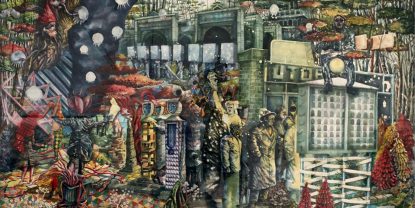Behrang Samadzadegan
Exhibited Artist
Behrang Samadzadegan (b. 1979, Tehran, Iran) learned the basics of art at the Center for the Intellectual Development of Child and Adolescent at a very young age and went to the vocational school of graphic design later on. He received his BFA from the Tehran University of Arts and his MFA from Tehran Tarbiat Modares University. In 2008, he received the Golden Feather from the first International Media Art Forum for Youth in Cairo. In 2009, he received the Visiting Arts artist residency award in Spike Island, Bristol, United Kingdom. In 2012, he was awarded the artist residency from the Atelierhaus Salzamt, Linz, Austria. He was also the recipient of the artist residency of the Cleveland Foundation Creative Fusion Artists Program, Cleveland, Ohio, USA. Since 2004, he has been giving lectures on art theory and holding workshops at the Sooreh University, Tehran University of Art, Aria Art Institute, and Mahe-Mehr Cultural & Art Institute. As a guest artist, he taught at the Painting Departments at Cleveland Institute of Art for a semester in 2015. Samadzadegan has been a jury member of the fourth Damonfar Biennial for Painting, the New Generation (Nasl-e-No) Annual for Painting, the Video Artist Festival of Isfahan, the Persbook Annual of Contemporary Arts, Vista Prize, Versus Biennial, and the Mohsen Projects Open Call. In his works, Behrang seeks to probe the possibility (or impossibility) of representing truth, identity, and history within the framework of aesthetic laws and to challenge the image’s capacity for displaying these concepts. As a scholar and curator, he enjoys discovering and studying new artistic phenomena and believes in rethinking and challenging the established rules and requirements of art. Painting has been Behrang’s main focus. The subject matters of his works are drawn from images and narratives of contemporary Iranian history, which he combines with fictional stories and the aesthetics of painting. His goal, however, is not to represent historical narratives. The image of history, he believes, is a personal matter created under the influence of visual and aesthetic stereotypes; a combination of confusion, chaos, and a futile quest for reaching unattainable truth. Similarly, throughout his work, he pursues hierarchies and systems that distort the representation of information and the consciousness; systems such as politics, aesthetics, and history that can empty and sterilize contexts and create arbitrary hierarchies that cause confusion and eliminate the possibility of recording and expressing the truth. As he sees it, this system also governs the creation of art, and it does not intend to reach a destination or find a way to redemption; the only thing that remains is a search for an alternative way and finding a new hope to get out of the turmoil and crisis. Thus, his creative process is influenced by the past, paralleled by the experience of living in the present. Moreover, in his painting progress, Behrang seeks an understanding of painting as a medium that is working on new terms in a post-medium condition. He has an interest in how painting might be used as a tool for openly addressing and reflecting on aspects of cultural identity, which might position itself against painting’s declarative aspect. He collates motifs from personal and collective shared experiences. These motifs are often derived from multiple contexts and eras, and share properties of ambiguity. Behrang believes that painting is where seemingly incontestable things are reconsidered and put into new relationships with other things. Thus, painting lends itself well to reflection.











